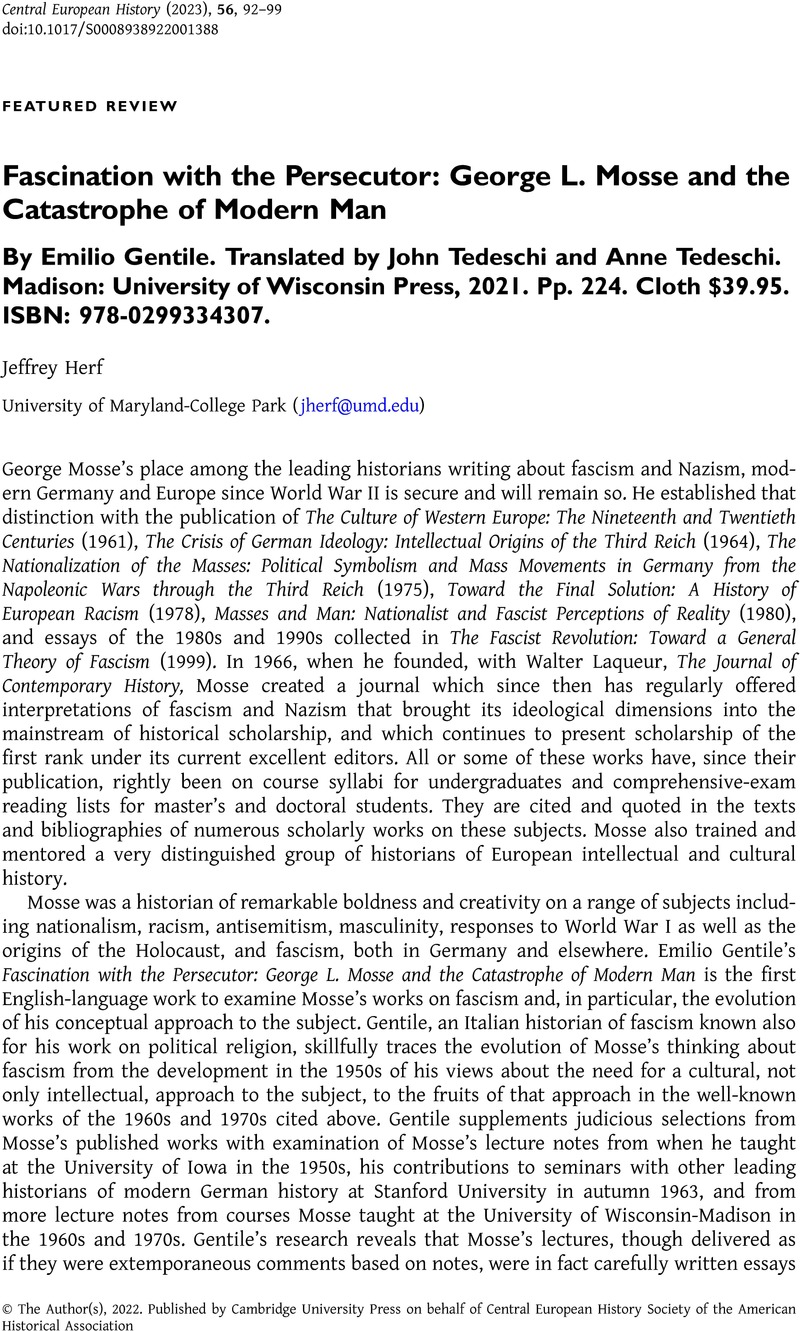No CrossRef data available.
Article contents
Fascination with the Persecutor: George L. Mosse and the Catastrophe of Modern Man By Emilio Gentile. Translated by John Tedeschi and Anne Tedeschi. Madison: University of Wisconsin Press, 2021. Pp. 224. Cloth $39.95. ISBN: 978-0299334307.
Review products
Published online by Cambridge University Press: 12 December 2022
Abstract

- Type
- Featured Review
- Information
- Copyright
- Copyright © The Author(s), 2022. Published by Cambridge University Press on behalf of Central European History Society of the American Historical Association
References
1 George L. Mosse, “The Mystical Origins of Nationalism,” Journal of the History of Ideas (January-March 1961): 218–27; reprinted in Mosse, George L., Masses and Man: Nationalist and Fascist Perceptions of Reality (New York: Howard Fertig, 1980)Google Scholar and cited in Gentile, 217.
2 Walter Laqueur's published work on antisemitism, fascism, the Holocaust, foreign intelligence, the Soviet Union, terrorism, and Zionism is vast. On fascism in particular, see Laqueur, Walter, ed., Fascism: A Reader's Guide: Analyses, Interpretations, Bibliography (Berkeley and Los Angeles: University of California Press, 1976)Google Scholar.
3 Herf, Jeffrey, “From the Margins to the Mainstream: Refugees and the Successors on the Jewish Question, Antisemitism, and the Holocaust in German History,” in The Second Generation: Émigrés from Nazi Germany as Historians, edited by Daum, Andreas W., Lehmann, Hartmut, and Sheehan, James J. (New York: Berghahn Books, 2016), 197–209Google Scholar.
4 Mosse, Gorge L., The Culture of Western Europe: The Nineteenth and Twentieth Centuries (Chicago: Rand McNally, 1961), 5–6Google Scholar; cited in Gentile, 41.
5 On this issue, see Herf, Jeffrey, Reactionary Modernism: Technology, Culture and Politics in Weimar and the Third Reich (New York: Cambridge University Press, 1984)Google Scholar; and Herf, “The Displacement of German History in The Dialectic of Enlightenment,” in “Politisierung der Wissenschaft”. Jüdische, völkische und andere Wissenschaftler an der Universität Frankfurt am Main vor und nach 1933, edited by Moritz Epple, Johannes Fried, Raphael Gross, and Janus Gudian (Düsseldorf: Wallstein Verlag, 2016), 447–468.
6 Mosse, The Culture of Western Europe, 347–348; cited in Gentile, 52–53.
7 On antisemitism and the Sonderweg, see Aschheim, Steven E., “Nazism, Normalcy, and the German Sonderweg,” in Aschheim, Steven E., In Times of Crisis: Essays on European Culture, Germans, and Jews (Madison: University of Wisconsin, 2001), 105–121Google Scholar.
8 George Mosse, “What is Fascism?”, lecture delivered at “The Intellectual Foundations of National Socialism” seminar, Center of European Studies, Stanford University, autumn 1963, cited in Gentile, 59–60.
9 Mosse, “What is Fascism?”, 67.
10 Wildt, Michael, The Uncompromising Generation: The Nazi Leadership of the Reich Security Main Office, translated by Tom Lampert (Madison: University of Wisconsin Press, 2009)Google Scholar.
11 Remy, Steven P., The Heidelberg Myth: The Nazification and Denazification of a German University (Cambridge, Mass.: Harvard University Press, 2002)Google Scholar.
12 Kaplan, Marion, Between Dignity and Despair: Jewish Life in Nazi Germany (New York: Oxford University Press, 1999)CrossRefGoogle Scholar; Friedländer, Saul, Nazi Germany and the Jews, Vol. 1: The Years of Persecution, 1933–1939 (New York: HarperCollins, 1997)Google Scholar.
13 Mosse, George, “Albert Speer's Hitler,” Quadrant (October 1976), 54Google Scholar; cited in Gentile, 88.
14 Bretchken, Magnus, Albert Speer. Eine deutsche Karriere (Munich: Siedler Verlag, 2017), 443Google Scholar, 457.
15 On the origins of racism in the Spanish Inquisition, see Netanyahu, Benzion, The Origins of the Inquisition in Fifteenth-Century Spain (New York: Random House, 1995)Google Scholar; Poliakov, Leon, The History of Antisemitism, Vol. 2: From Mohammed to the Marranos (Philadelphia: University of Pennsylvania Press, 2003)Google Scholar. Poliakov's work was first published in France in 1965 and first translated into English in 1973. On early European racism towards Blacks, see Jordan, Winthrop D., White over Black: American Attitudes Toward the Negro, 1515-1812 (Chapel Hill: University of North Carolina, 1968)Google Scholar, and Frederickson, George M., Racism: A Short History (Princeton: Princeton University Press, 2015)CrossRefGoogle Scholar.
16 On the long-term in the Western tradition, see Nirenberg, David, Anti-Judaism: The Western Tradition (New York: W.W. Norton, 2014)Google Scholar.
17 See e.g., Herf, Jeffrey, The Jewish Enemy: Nazi Propaganda during World War II and the Holocaust (Cambridge, Mass.: Harvard University Press, 2006)CrossRefGoogle Scholar.
18 George L. Mosse, “The Holocaust and Modern Manners and Morals,” cited in Gentile, 128.
19 George Mosse to Lucy S. Dawidowicz, April 7, 1975, cited in Sinkoff, Nancy, From Left to Right: Lucy S. Dawidowicz, the New York Intellectuals, and the Politics of History (Detroit: Wayne State University Press, 2020), 301Google Scholar.
20 Mosse, George L., Toward the Final Solution: A History of European Racism (New York: Howard Fertig, 1978), 202Google Scholar.
21 Mosse, Toward the Final Solution, 204.
22 Mosse, Toward the Final Solution, 231.
23 Frederickson, Racism; Herf, Jeffrey, “A Comparative Perspective on Antisemitism, Radical Antisemitism in the Holocaust and American White Racism,” The Journal of Genocide Research, Vol. 9, No. 4 (December 2007): 575–600CrossRefGoogle Scholar.


